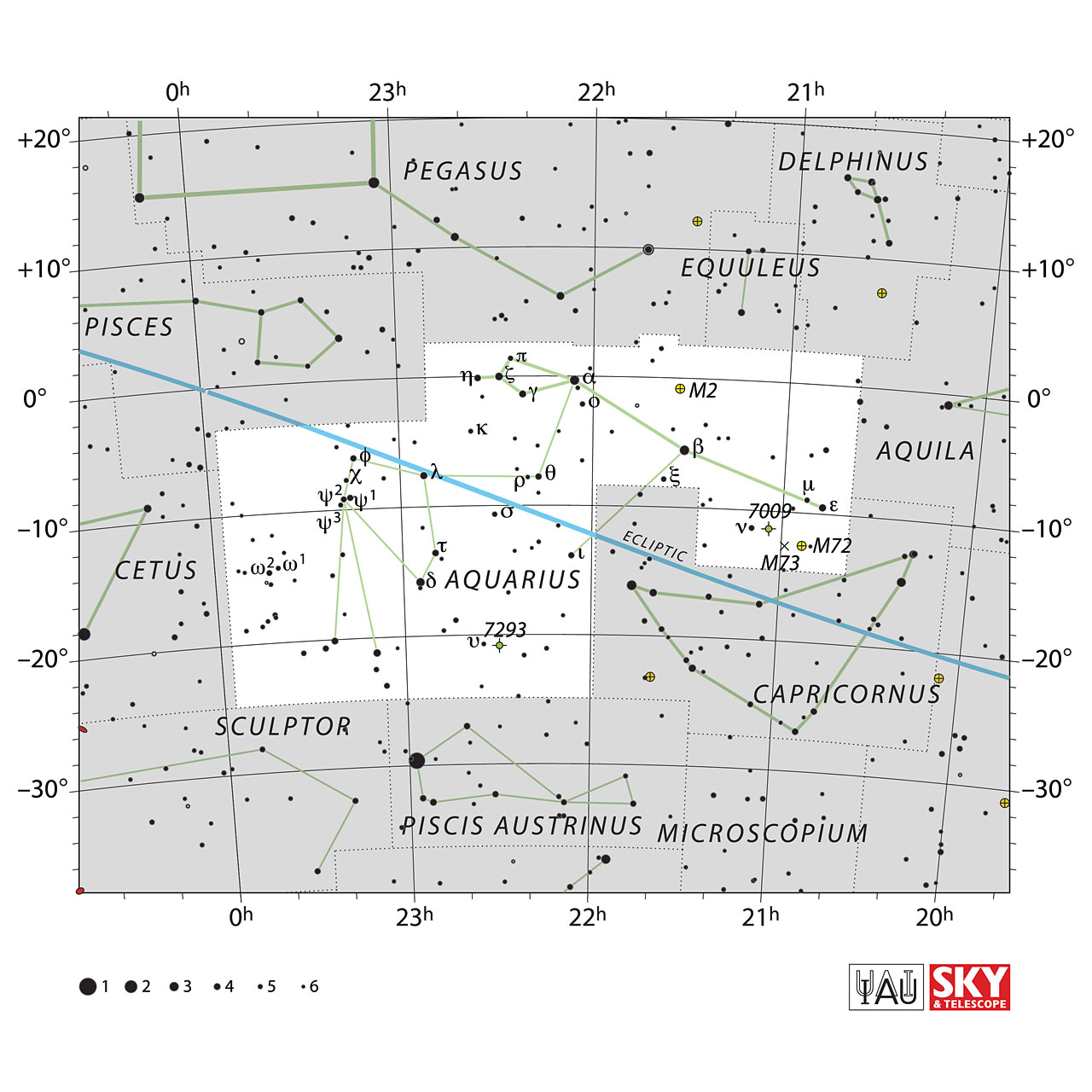Aquarius


Aquarius is the tenth largest constellation, visible just south of the celestial equator in the months around August.
It is one of the fainter zodiacal constellations, lacking any stars brighter than third magnitude, but does have a dozen stars of fourth magnitude. It is also home to the bright globular cluster M2.
Aquarius is usually depicted pouring water from a jar. The stream of water ends in the mouth of the southern fish, Piscis Austrinus, marked by the star Fomalhaut beneath Aquarius’ feet. The meandering path of the stream itself is marked by a line of 20 faint stars.
He is usually identified as Ganymede, in classical mythology the wine-waiter tothe gods and one of Zeus’ many lovers.
Greek Myth: The name most often associated with the constellation Aquarius is that of Ganymede, son of Tros, King of Troy. Ganymede was an extremely handsome young man, the most handsome the gods and goddesses had ever seen. While attending to his father’s flocks on Mount Ida,Ganymede caught the attention of Zeus. Zeus sent his messenger eagle, Aquila, down to earth with instructions to bring Ganymede back up to Mount Olympus. On Mount Olympus, Ganymede served the gods by bringing them water whenever they needed it. He also served as cup bearer to Zeus. He was honored for his service by Zeus, who placed a constellation called Aquarius, which means water carrier, among the stars.
Aquarius is identified as GU.LA “The Great One” in the Babylonian star catalogues and represents the god Ea himself, who is commonly depicted holding an overflowing vase.
In Ancient Egypt astronomy, Aquarius was associated with the annual flood of the Nile; the banks were said to flood when Aquarius put his jar into the river, beginning spring.
The name in the Hindu zodiac is likewise kumbha “water-pitcher”.
Being a zodiac constellation, Aquarius has its own symbol ![]() and emoji ♒
and emoji ♒
Aquarius contains:
-
Stars
- Sadalsuud (mag 2.9)
- Sadalmelik (mag 2.9)
- Skat (mag 3.3)
- c²-Aqr (mag 3.7)
- λ-Aqr (mag 3.8)
- Albali (mag 3.8)
- Sadachbia (mag 3.9)
- b¹-Aqr (mag 4.0)
- η-Aqr (mag 4.0)
- τ²-Aqr (mag 4.0)
- ζ¹-Aqr (mag 4.1)
- Ancha (mag 4.2)
- φ-Aqr (mag 4.2)
- ψ¹-Aqr (mag 4.2)
- ι-Aqr (mag 4.3)
- b²-Aqr (mag 4.4)
- ψ²-Aqr (mag 4.4)
- ζ²-Aqr (mag 4.4)
- EN Aqr (mag 4.5)
- c¹-Aqr (mag 4.5)
- ω²-Aqr (mag 4.5)
- ν-Aqr (mag 4.5)
- g-Aqr (mag 4.7)
- ξ-Aqr (mag 4.7)
- b³-Aqr (mag 4.7)
-
Open Clusters
- Messier 73 (mag 8.9)
- NGC 7005
-
Globular Clusters
- Messier 2 (mag 6.6)
- Messier 72 (mag 9.2)
- NGC 7492 (mag 11.2)
-
Galaxy
- NGC 7727 (mag 10.7)
- NGC 7606 (mag 10.8)
- NGC 7723 (mag 11.1)
- NGC 7184 (mag 11.2)
- NGC 6978 (mag 11.3)
- NGC 7721 (mag 11.8)
- NGC 7392 (mag 11.8)
- NGC 7252 (mag 12.1)
- NGC 7218 (mag 12.1)
- NGC 7371 (mag 12.1)
- NGC 7302 (mag 12.1)
- NGC 6962 (mag 12.1)
- NGC 7416 (mag 12.3)
- NGC 7171 (mag 12.3)
- NGC 7309 (mag 12.5)
- NGC 7180 (mag 12.5)
- IC 1438 (mag 12.6)
- NGC 7377 (mag 12.8)
- NGC 6967 (mag 12.8)
- NGC 7285 (mag 12.8)
- NGC 7300 (mag 12.9)
- NGC 7183 (mag 12.9)
- NGC 7284 (mag 13.0)
- NGC 6964 (mag 13.0)
- NGC 7724 (mag 13.0)
View Aquarius in 3D 
Source: Wikipedia, in-the-sky.org
Image Courtesy: Sky&Telescope & IAU, Illustration Images linked from Urania's Mirror on Wikmedia Commons by Sidney Hall
Image Courtesy: Sky&Telescope & IAU, Illustration Images linked from Urania's Mirror on Wikmedia Commons by Sidney Hall
